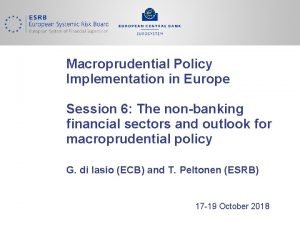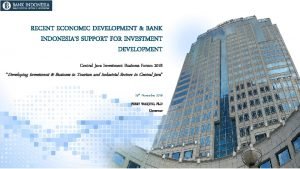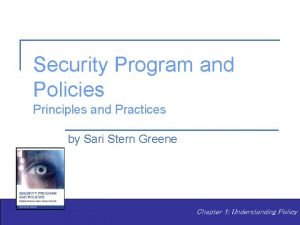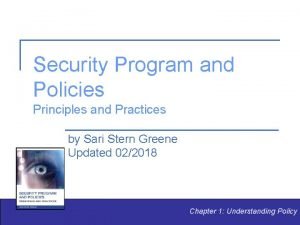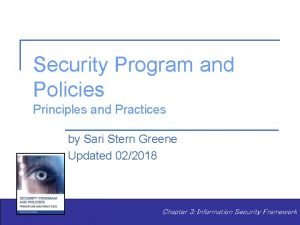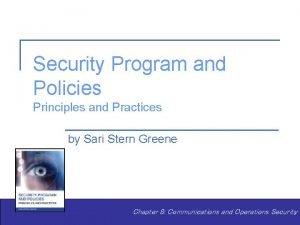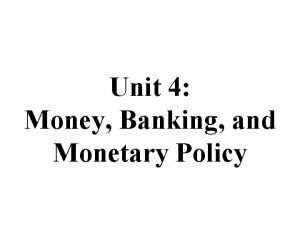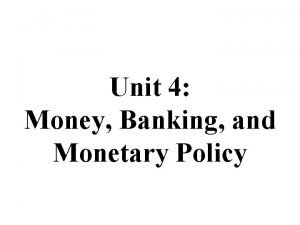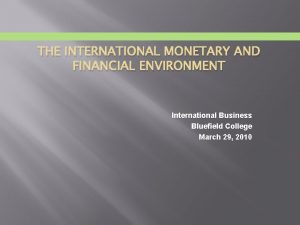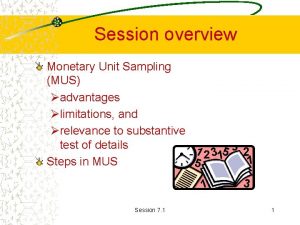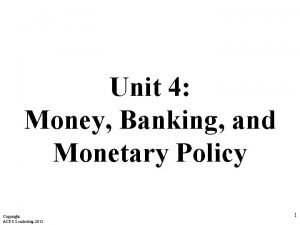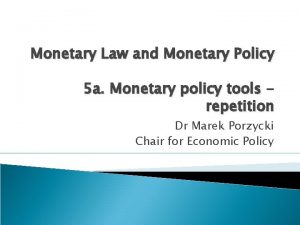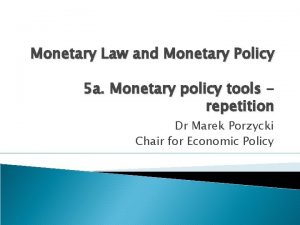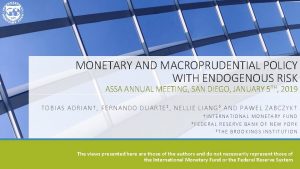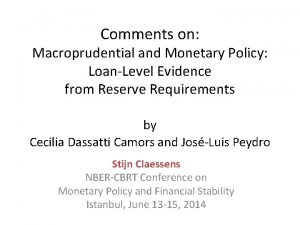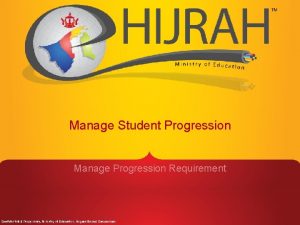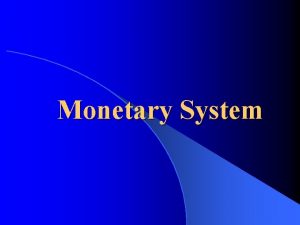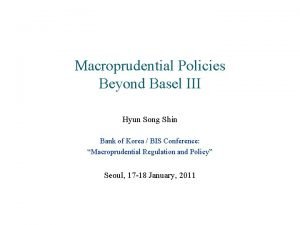Discussion of Monetary and Macroprudential Policies to Manage

















- Slides: 17

Discussion of «Monetary and Macroprudential Policies to Manage Capital Flows» by Juan Pablo Medina and Jorge Roldós Hakan Kara Central Bank of the Republic of Turkey 2013 CENTRAL BANK MACROECONOMIC MODELING WORKSHOP “Understanding the Mechanisms and Effects of New Policy Instruments” November 7 -8, 2013 İstanbul

Outline 1. 2. 3. 4. 5. 6. What does the paper do? Main contributions Appraisal Can this model be used for policy advice to EMEs? On the choice of alternative policy frameworks RR as a policy tool Shock robustness 2

Motivation, main question, and findings Ø Motivated by the post-Lehman behavior of EMEs (Brasil, Turkey, Colombia, Peru) Ø Main Question: What is the appropriate mix of monetary and macroprudential policies when changes in world interest rate is the dominating shock? Ø Answer: Using a macroprudential instrument (such as RR) improves welfare significantly compared to IT regime. Ø Each instrument (policy rate and RR) should be paired with the objective on which it has the most influence. (Immediate thought: do we really need a 45 equation model to make these conclusions? ) 3

Methodology and Execution Ø Set up a model with financial friction and nominal rigidity • Enhanced financial accelerator, price stickiness Ø Simulate the model with a foreign interest rate path similar to the one observed in post-Lehman period. Ø Rank the welfare under various policy frameworks • Strict inflation targeting (IT) (inflation always hits the target) • Taylor rule • Strict IT with a macroprudential rule (reserve requirements) 4

Main Contributions of the paper Ø Modeling: RR’s under financial and nominal frictions Ø Policy: Simulating a specific type of policy problem which is very relevant for many EMEs. • How to respond to capital flow cycles driven by extraordinary movements in global interest rates? Foreign Interest Rate 5

Appraisal Ø Very relevant and timely question Ø Sophisticated, state of the art modeling with plenty of useful policy implications Ø Well-executed (more intuition may be helpful) 6

Easy to beat strict IT or Taylor Rule 7

Is this an emerging economy model? Ø Involves financial accelerator, rather than sudden stop: Agency problem (Bernanke, Gertler and Gilchrist 1999) + fire sales (Choi and Cook 2012) Acceleration mechanism is not specific to emerging economies Ø The paper includes an extended version with dollarization but share of external credit is fixed, only valuation effects: i*↓ , rer↑ , net worth↑ , less need for borrowing Ø Credit is mostly determined by the demand side? Ø The evidence shows that capital flows and credit cycles are mainly driven by supply (leverage behavior) of global banks. 8

Capital Flows and Accelerating Mechanism: An Alternative View Lower Global Interest Rates Capital Inflows Currency appreciation and improved networth Easing colleteral constraints 9

Capital Flows and Accelerating Mechanism: An Alternative View Lower Global Interest Rates Capital Inflows Currency appreciation and improved networth Increased supply of external credit Easing colleteral constraints 10

Implications for the Welfare Function 11

Conclusion on Turkish Monetary Policy: How fair is it? Ø «In particular, while the “natural” interest rate of this economy declines with the world rate, the policy rate may indeed need to be increased to accommodate reserve requirements—in contrast to the Turkey experience. » Ø This conclusion reflects model specific dynamics. Ø The results would have possibly changed if: • the credit were driven by the leverage cycles of global banks (as evidenced by Bruno and Shin 2013) • the objective of the policy had incorporated financial stability (reducing the probability of a sudden stop and/or Bo. P crisis). 12

Reserve Requirements as a Macroprudential Tool In the model RR affects credit through two channels Ø : Cost channel Ø Liquidity Channel: Ø What if the CB directly participates in the interbank market? • Would liquidity channel still work? May be to a lesser extent. 13

Robustness: what about «pull factors» ? Ø The paper considers a specific (foreign interest rate) shock, yet draws broader conclusions regarding the policy mix. Ø How would the results change if the capital flows were driven by pull factors rather than foreign interest rates? Ø A fall in country credit risk Ø Productivity shock 14

Discussion of «Monetary and Macroprudential Policies to Manage Capital Flows» by Juan Pablo Medina and Jorge Roldós Hakan Kara Central Bank of the Republic of Turkey 2013 CENTRAL BANK MACROECONOMIC MODELING WORKSHOP “Understanding the Mechanisms and Effects of New Policy Instruments” November 7 -8, 2013 İstanbul

16

Capital Flows, Credit , and Exchange Rate Cycles (HP filtered, standardized) 2 Loans (t) REER (t+2) Inflows (t+2) 1. 5 1 0. 5 0 -0. 5 -1 -1. 5 2013 Q 2 2012 Q 4 2012 Q 2 2011 Q 4 2011 Q 2 2010 Q 4 2010 Q 2 2009 Q 4 2009 Q 2 2008 Q 4 2008 Q 2 2007 Q 4 2007 Q 2 2006 Q 4 2006 Q 2 2005 Q 4 2005 Q 2 Source: CBRT. 2004 Q 4 2004 Q 2 -2 17
 Macroprudential policies
Macroprudential policies Macroeconomics lesson 2 activity 45
Macroeconomics lesson 2 activity 45 Short run effects of expansionary monetary policy
Short run effects of expansionary monetary policy Macroprudential policy
Macroprudential policy Jisdor fixing
Jisdor fixing Fractional distillation conclusion
Fractional distillation conclusion Sdlc principles and practices
Sdlc principles and practices Recruitment selection and induction policies and procedures
Recruitment selection and induction policies and procedures Security program and policies principles and practices
Security program and policies principles and practices Security program and policies principles and practices
Security program and policies principles and practices Security program and policies principles and practices
Security program and policies principles and practices Security program and policies principles and practices
Security program and policies principles and practices Unit 4 money banking and monetary policy
Unit 4 money banking and monetary policy Unit 4 money banking and monetary policy
Unit 4 money banking and monetary policy International monetary and financial environment
International monetary and financial environment International financial environment
International financial environment Monetary unit sample
Monetary unit sample Unit 4 money and monetary policy
Unit 4 money and monetary policy



